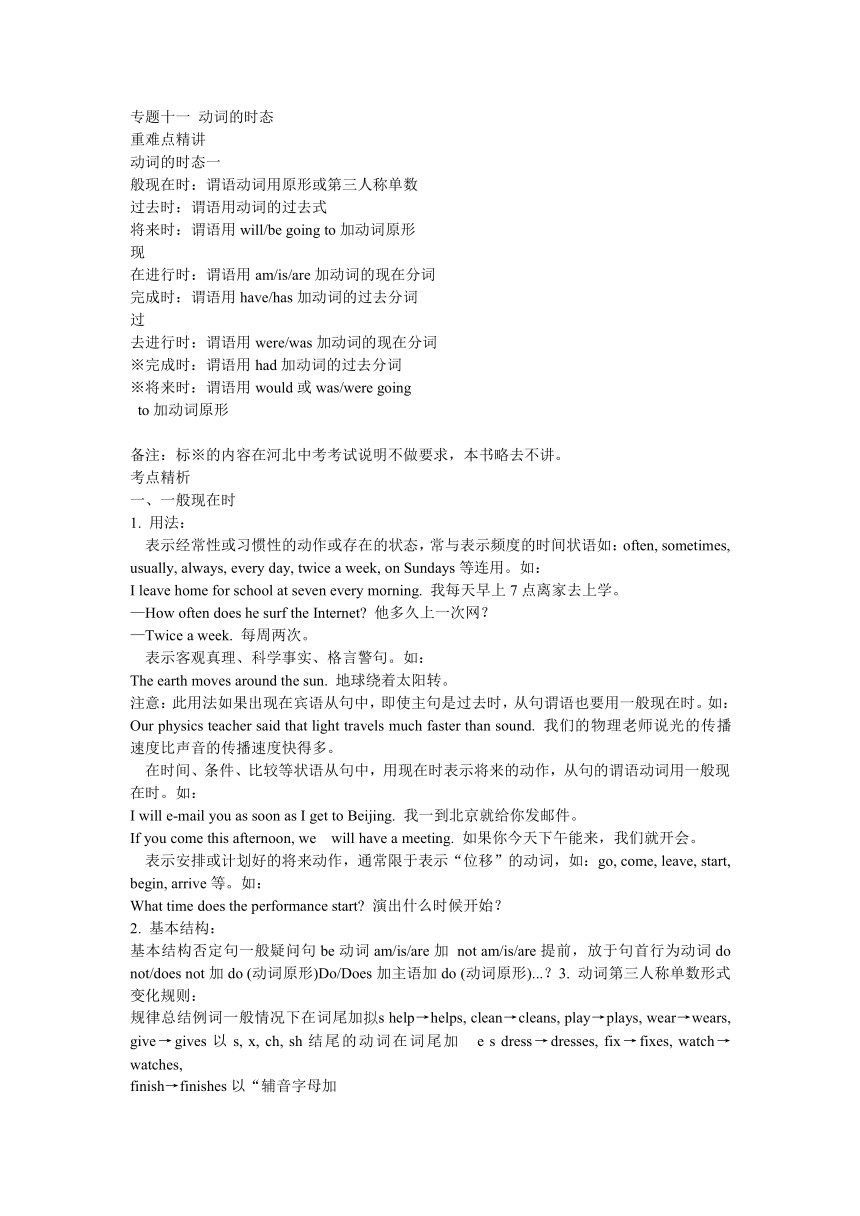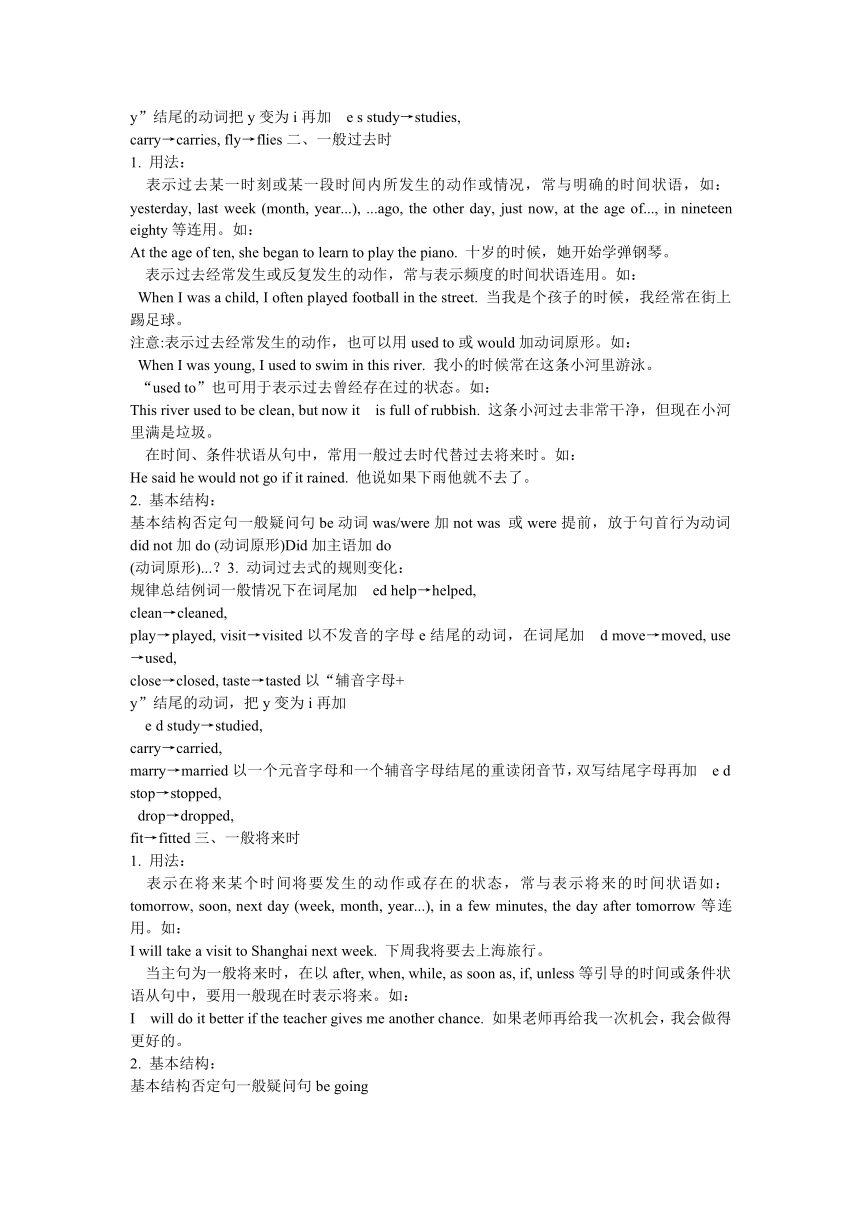【重难点精讲】河北省2014届中考英语外研考点解密:第二部分 语法专题突破 专题十一 动词的时态
文档属性
| 名称 | 【重难点精讲】河北省2014届中考英语外研考点解密:第二部分 语法专题突破 专题十一 动词的时态 |  | |
| 格式 | zip | ||
| 文件大小 | 18.2KB | ||
| 资源类型 | 教案 | ||
| 版本资源 | 外研版 | ||
| 科目 | 英语 | ||
| 更新时间 | 2014-06-03 22:29:09 | ||
图片预览


文档简介
专题十一 动词的时态
重难点精讲
动词的时态一
般现在时:谓语动词用原形或第三人称单数
过去时:谓语用动词的过去式
将来时:谓语用will/be going to加动词原形
现
在进行时:谓语用am/is/are加动词的现在分词
完成时:谓语用have/has加动词的过去分词
过
去进行时:谓语用were/was加动词的现在分词
※完成时:谓语用had加动词的过去分词
※将来时:谓语用would或was/were going
to加动词原形
备注:标※的内容在河北中考考试说明不做要求,本书略去不讲。
考点精析
一、一般现在时
1. 用法:
?表示经常性或习惯性的动作或存在的状态, ( http: / / www.21cnjy.com )常与表示频度的时间状语如:often, sometimes, usually, always, every day, twice a week, on Sundays等连用。如:
I leave home for school at seven every morning. 我每天早上7点离家去上学。
—How often does he surf the Internet 他多久上一次网?
—Twice a week. 每周两次。
?表示客观真理、科学事实、格言警句。如:
The earth moves around the sun. 地球绕着太阳转。
注意:此用法如果出现在宾语从句中,即使主句是过去时,从句谓语也要用一般现在时。如:
Our physics teacher s ( http: / / www.21cnjy.com )aid that light travels much faster than sound. 我们的物理老师说光的传播速度比声音的传播速度快得多。
?在时间、条件、比较等状语从句中,用现在时表示将来的动作,从句的谓语动词用一般现在时。如:
I will e-mail you as soon as I get to Beijing. 我一到北京就给你发邮件。
If you come this afternoon, we?will have a meeting. 如果你今天下午能来,我们就开会。
?表示安排或计划好的将来动作,通常限于表示 ( http: / / www.21cnjy.com )“位移”的动词,如:go, come, leave, start, begin, arrive等。如:
What time does the performance start 演出什么时候开始?
2. 基本结构:
基本结构否定句一般疑问句b ( http: / / www.21cnjy.com )e动词am/is/are加 not am/is/are提前,放于句首行为动词do not/does not加do (动词原形)Do/Does加主语加do (动词原形)...?3. 动词第三人称单数形式变化规则:
规律总结例词一般情况下在词尾加?s h ( http: / / www.21cnjy.com )elp→helps, clean→cleans, play→plays, wear→wears, give→gives以s, x, ch, sh结尾的动词在词尾加?e s dress→dresses, fix→fixes, watch→watches,
finish→finishes以“辅音字母加
y”结尾的动词把y变为i再加?e s study→studies,
carry→carries, fly→flies二、一般过去时
1. 用法:
?表示过去某一时刻或某一段时间内所 ( http: / / www.21cnjy.com )发生的动作或情况,常与明确的时间状语,如:yesterday, last week (month, year...), ...ago, the other day, just now, at the age of..., in nineteen eighty等连用。如:
At the age of ten ( http: / / www.21cnjy.com ), she began to learn to play the piano. 十岁的时候,她开始学弹钢琴。
?表示过去经常发生或反复发生的动作,常与表示频度的时间状语连用。如:
When I was a child, I ( http: / / www.21cnjy.com ) often played football in the street. 当我是个孩子的时候,我经常在街上踢足球。
注意:表示过去经常发生的动作,也可以用used to或would加动词原形。如:
When I was young, I used to swim in this river. 我小的时候常在这条小河里游泳。
“used to”也可用于表示过去曾经存在过的状态。如:
This river us ( http: / / www.21cnjy.com )ed to be clean, but now it?is full of rubbish. 这条小河过去非常干净,但现在小河里满是垃圾。
?在时间、条件状语从句中,常用一般过去时代替过去将来时。如:
He said he would not go if it rained. 他说如果下雨他就不去了。
2. 基本结构:
基本结构否定句一般疑问句 ( http: / / www.21cnjy.com )be动词was/were加not was 或were提前,放于句首行为动词did not加do (动词原形)Did加主语加do
(动词原形)...?3. 动词过去式的规则变化:
规律总结例词一般情况下在词尾加?ed help→helped,
clean→cleaned,
play→played, visit→visited以不发音的字母e结尾的动词,在词尾加?d move→moved, use→used,
close→closed, taste→tasted以“辅音字母+
y”结尾的动词,把y变为i再加
?e d study→studied,
carry→carried,
marry→married以一个元音字母和一个辅音字母结尾的重读闭音节,双写结尾字母再加?e d stop→stopped,
drop→dropped,
fit→fitted三、一般将来时
1. 用法:
?表示在将来某个时间将要发生的动作或存 ( http: / / www.21cnjy.com )在的状态,常与表示将来的时间状语如:tomorrow, soon, next day (week, month, year...), in a few minutes, the day after tomorrow等连用。如:
I will take a visit to Shanghai next week. 下周我将要去上海旅行。
?当主句为一般将来时,在以after, ( http: / / www.21cnjy.com ) when, while, as soon as, if, unless等引导的时间或条件状语从句中,要用一般现在时表示将来。如:
I?will do it bett ( http: / / www.21cnjy.com )er if the teacher gives me another chance. 如果老师再给我一次机会,我会做得更好的。
2. 基本结构:
基本结构否定句一般疑问句be going
to加do am/is/are
not going to am/is/are提前,放于句首will/shall
加do will not
(will not) do will或shall提前,放于句首四、现在进行时
1. 用法:
?表示说话时刻正在发生的动作,或者包括说 ( http: / / www.21cnjy.com )话时刻在内的一段时间内正在进行的动作。常用的时间状语及标志词:now, listen, look, at the moment等。如:
Listen!Someone is playing the piano in the next room. 听!有人在隔壁房间弹钢琴。
?表示一种渐进的过程。如:
My younger brother ( http: / / www.21cnjy.com ) is becoming more and more interested in English. 我弟弟对英语越来越感兴趣。
?与always, all the time, forever等连用,表示某种强烈的感情。如:
He is always thinki ( http: / / www.21cnjy.com )ng of doing more for other people. 他总是想着为其他人多做一些事情。
?表示位移的动词,如:go, come, leave, start, arrive等,其现在进行时形式可表示将来。如:
My friend is coming for dinner. 我朋友要来吃饭。
She is leaving for Beijing next week. 她下周就要启程去北京。
2. 基本结构:
基本结构否定句一般疑问句be加现在分词
(am/is/are加doing)be加not加现在
分词(am/is/are
not加doing)be提前,
放于句首 3. 现在分词的变化规则:
规律总结例词一般情况下在词尾加?i n g help→helping, clean→cleaning,
play→playing, v ( http: / / www.21cnjy.com )isit→visiting以不发音的字母e结尾的动词,先去e再在词尾加?i n g move→moving, use→using,
close→closing, make ( http: / / www.21cnjy.com )→making以一个元音字母和一个辅音字母结尾的重读闭音节,双写末尾字母再加?i n g stop→stopping, drop→dropping,
run→running, put→putt ( http: / / www.21cnjy.com )ing以?ie结尾的动词,变ie为y,再加?i n g lie→lying, die→dying五、现在完成时
1. 用法:
?表示动作发生在过去,强调该动作对现在产生的影响或结果。常与时间状语already, yet, never, recently等连用。如:
I have already ( http: / / www.21cnjy.com ) seen the film. I think it?is wonderful. 我已看过这部电影了,感觉挺棒的。
Have you decided yet 你已经决定了吗?
注意:already 常用于肯定句句中或句末;yet常用于一般疑问句或否定句句末。
?表示“过去的动作”一直延续至今并有可能继续下去,常与for或since连用。如:
I have learned Engl ( http: / / www.21cnjy.com )ish since 10 years ago (for 10 years). 自从10年前起我就学英语了。
注意:for后接时间段;而since后接过去的时间点或从句(谓语动词用一般过去时)。
?表示刚刚或最近发生的动作或状态,常与时间状语:just, in the past few days/weeks等连用。如:
I have just phoned him. 我刚刚给他打过电话。
?表示过去的体验或经历,常用时间状语有:before, ever, once, many times等。如:
I have been to the Great Wall many times. 我去过长城好多次了。
注意:have (has) been to与have (has) gone to的区别:
①have (has) been to ( http: / / www.21cnjy.com ) 去过某地(说话时已回来)。如:He has been to Shanghai. 他去过上海。(已回来了)
②have (has) gone to 已去某地(说话时还没回来)。如:
He has gone to Shanghai. 他去上海了。(还没回来)
2. 基本结构:
基本结构否定句一般疑问句have/has加动
词过去分词have/has not加
动词过去分词have/has提前,放于句 ( http: / / www.21cnjy.com )首3. 用于现在完成时的动词必须是延续性动词,表示从过去一直延续到现在的动作。常见的一些非延续动词与延续性动词的转化如下表:
非延续性动词borrow buy leave ( http: / / www.21cnjy.com ) 延续性动词 keep have be away 非延续性动词die join start/begin延续性动词 be dead be in be on六、过去进行时
1. 用法:
?表示过去某一时刻或某一时刻内正在进 ( http: / / www.21cnjy.com )行或发生的动作。动作发生的特指时间常用一个短语或时间状语从句来表明,如:at seven o'clock yesterday, at this time, last night, from seven to nine, when或while引导的时间状语从句等。如:
My family were watching TV at this time yesterday. 昨天这个时候我们一家人在看电视。
注意:
①以when引导的时间状语从句中,从句动作用一般过去时,主句用过去进行时。表示一个动作发生时,另一个动作正在进行。如:
When he called me, I was having dinner. 他给我打电话时,我正在吃晚饭。
②以while引导的时间状语从句中,从句与主句的动作在过去某一时刻同时进行,while常译为“当什么的时候,同时”。如:
Tom was doing his h ( http: / / www.21cnjy.com )omework while his younger sister was watching TV. 汤姆在做作业,同时他的妹妹在看电视。
?用于具体的语境之中。如:
—What did the teacher say just now 老师刚才说什么了?
—Sorry, I did not ca ( http: / / www.21cnjy.com )tch it. I was thinking something else. 对不起,我没听见。当时我在想其他事了。
2. 基本结构:
基本结构 be加现在分词
(was/were加doing)否定句be加not加
现在分词(was/were 一般疑问句
not加doing)was或were提前,放于句首【方法突破】
1. 语境推断法
分析河 北近五年真题,单项选择对时 ( http: / / www.21cnjy.com )态的考查愈来愈侧重语境。在语境中对动词时态的考查是要求学生通过上下句语境的时间逻辑关系,让学生学会在特定语境下正确使用时态。可从以下角度解题:
①读懂句意,理解句子意思中已经发生的动作所表达的时态是哪种时态。同时,分析选项,理解每个选项所要表达的时态。
②分析句子中所给动作与需要填的动作的 ( http: / / www.21cnjy.com )先后顺序,从句子的前后意思来推测“时间点”。如:句子中给出的动作是一般现在时,若所填动作在给出的动作之前已经发生了,需要用一般过去时;若所填的动作与给出的动作在一定时间里同时发生,则用现在进行时;若所填动作晚于给出的动作,则用一般将来时。需要注意的是一些比较特殊的用法,如:表示客观真理的、科学事实的都用一般现在时。在平时的练习中可结合时间轴进行分析。
2. 时间状语提示法
虽然河北中考单项选择对动词时态的考查淡 ( http: / / www.21cnjy.com )化了时间状语的提示,但时间状语作为动词时态的重要组成部分,学生也要重点掌握。由句子中的时间状语来判断用现在时态还是过去时态。一些特定的时间状语往往标志着一些特定的时态。如:
now, at present标志着一般现在时或现在进行时;
yesterday, last week, a few years ago标志着一般过去时;
at that time, at the time, at this time yesterday标志着过去进行时;
tomorrow, next ( http: / / www.21cnjy.com ) week, in an hour,at this time tomorrow, at five tomorrow afternoon标志着一般将来时。
除了上述时间状语提示时态, ( http: / / www.21cnjy.com )某些副词也有这种作用。如:often, always, usually, never, seldom等表示频率的副词,应用一般现在时或一般过去时。
重难点精讲
动词的时态一
般现在时:谓语动词用原形或第三人称单数
过去时:谓语用动词的过去式
将来时:谓语用will/be going to加动词原形
现
在进行时:谓语用am/is/are加动词的现在分词
完成时:谓语用have/has加动词的过去分词
过
去进行时:谓语用were/was加动词的现在分词
※完成时:谓语用had加动词的过去分词
※将来时:谓语用would或was/were going
to加动词原形
备注:标※的内容在河北中考考试说明不做要求,本书略去不讲。
考点精析
一、一般现在时
1. 用法:
?表示经常性或习惯性的动作或存在的状态, ( http: / / www.21cnjy.com )常与表示频度的时间状语如:often, sometimes, usually, always, every day, twice a week, on Sundays等连用。如:
I leave home for school at seven every morning. 我每天早上7点离家去上学。
—How often does he surf the Internet 他多久上一次网?
—Twice a week. 每周两次。
?表示客观真理、科学事实、格言警句。如:
The earth moves around the sun. 地球绕着太阳转。
注意:此用法如果出现在宾语从句中,即使主句是过去时,从句谓语也要用一般现在时。如:
Our physics teacher s ( http: / / www.21cnjy.com )aid that light travels much faster than sound. 我们的物理老师说光的传播速度比声音的传播速度快得多。
?在时间、条件、比较等状语从句中,用现在时表示将来的动作,从句的谓语动词用一般现在时。如:
I will e-mail you as soon as I get to Beijing. 我一到北京就给你发邮件。
If you come this afternoon, we?will have a meeting. 如果你今天下午能来,我们就开会。
?表示安排或计划好的将来动作,通常限于表示 ( http: / / www.21cnjy.com )“位移”的动词,如:go, come, leave, start, begin, arrive等。如:
What time does the performance start 演出什么时候开始?
2. 基本结构:
基本结构否定句一般疑问句b ( http: / / www.21cnjy.com )e动词am/is/are加 not am/is/are提前,放于句首行为动词do not/does not加do (动词原形)Do/Does加主语加do (动词原形)...?3. 动词第三人称单数形式变化规则:
规律总结例词一般情况下在词尾加?s h ( http: / / www.21cnjy.com )elp→helps, clean→cleans, play→plays, wear→wears, give→gives以s, x, ch, sh结尾的动词在词尾加?e s dress→dresses, fix→fixes, watch→watches,
finish→finishes以“辅音字母加
y”结尾的动词把y变为i再加?e s study→studies,
carry→carries, fly→flies二、一般过去时
1. 用法:
?表示过去某一时刻或某一段时间内所 ( http: / / www.21cnjy.com )发生的动作或情况,常与明确的时间状语,如:yesterday, last week (month, year...), ...ago, the other day, just now, at the age of..., in nineteen eighty等连用。如:
At the age of ten ( http: / / www.21cnjy.com ), she began to learn to play the piano. 十岁的时候,她开始学弹钢琴。
?表示过去经常发生或反复发生的动作,常与表示频度的时间状语连用。如:
When I was a child, I ( http: / / www.21cnjy.com ) often played football in the street. 当我是个孩子的时候,我经常在街上踢足球。
注意:表示过去经常发生的动作,也可以用used to或would加动词原形。如:
When I was young, I used to swim in this river. 我小的时候常在这条小河里游泳。
“used to”也可用于表示过去曾经存在过的状态。如:
This river us ( http: / / www.21cnjy.com )ed to be clean, but now it?is full of rubbish. 这条小河过去非常干净,但现在小河里满是垃圾。
?在时间、条件状语从句中,常用一般过去时代替过去将来时。如:
He said he would not go if it rained. 他说如果下雨他就不去了。
2. 基本结构:
基本结构否定句一般疑问句 ( http: / / www.21cnjy.com )be动词was/were加not was 或were提前,放于句首行为动词did not加do (动词原形)Did加主语加do
(动词原形)...?3. 动词过去式的规则变化:
规律总结例词一般情况下在词尾加?ed help→helped,
clean→cleaned,
play→played, visit→visited以不发音的字母e结尾的动词,在词尾加?d move→moved, use→used,
close→closed, taste→tasted以“辅音字母+
y”结尾的动词,把y变为i再加
?e d study→studied,
carry→carried,
marry→married以一个元音字母和一个辅音字母结尾的重读闭音节,双写结尾字母再加?e d stop→stopped,
drop→dropped,
fit→fitted三、一般将来时
1. 用法:
?表示在将来某个时间将要发生的动作或存 ( http: / / www.21cnjy.com )在的状态,常与表示将来的时间状语如:tomorrow, soon, next day (week, month, year...), in a few minutes, the day after tomorrow等连用。如:
I will take a visit to Shanghai next week. 下周我将要去上海旅行。
?当主句为一般将来时,在以after, ( http: / / www.21cnjy.com ) when, while, as soon as, if, unless等引导的时间或条件状语从句中,要用一般现在时表示将来。如:
I?will do it bett ( http: / / www.21cnjy.com )er if the teacher gives me another chance. 如果老师再给我一次机会,我会做得更好的。
2. 基本结构:
基本结构否定句一般疑问句be going
to加do am/is/are
not going to am/is/are提前,放于句首will/shall
加do will not
(will not) do will或shall提前,放于句首四、现在进行时
1. 用法:
?表示说话时刻正在发生的动作,或者包括说 ( http: / / www.21cnjy.com )话时刻在内的一段时间内正在进行的动作。常用的时间状语及标志词:now, listen, look, at the moment等。如:
Listen!Someone is playing the piano in the next room. 听!有人在隔壁房间弹钢琴。
?表示一种渐进的过程。如:
My younger brother ( http: / / www.21cnjy.com ) is becoming more and more interested in English. 我弟弟对英语越来越感兴趣。
?与always, all the time, forever等连用,表示某种强烈的感情。如:
He is always thinki ( http: / / www.21cnjy.com )ng of doing more for other people. 他总是想着为其他人多做一些事情。
?表示位移的动词,如:go, come, leave, start, arrive等,其现在进行时形式可表示将来。如:
My friend is coming for dinner. 我朋友要来吃饭。
She is leaving for Beijing next week. 她下周就要启程去北京。
2. 基本结构:
基本结构否定句一般疑问句be加现在分词
(am/is/are加doing)be加not加现在
分词(am/is/are
not加doing)be提前,
放于句首 3. 现在分词的变化规则:
规律总结例词一般情况下在词尾加?i n g help→helping, clean→cleaning,
play→playing, v ( http: / / www.21cnjy.com )isit→visiting以不发音的字母e结尾的动词,先去e再在词尾加?i n g move→moving, use→using,
close→closing, make ( http: / / www.21cnjy.com )→making以一个元音字母和一个辅音字母结尾的重读闭音节,双写末尾字母再加?i n g stop→stopping, drop→dropping,
run→running, put→putt ( http: / / www.21cnjy.com )ing以?ie结尾的动词,变ie为y,再加?i n g lie→lying, die→dying五、现在完成时
1. 用法:
?表示动作发生在过去,强调该动作对现在产生的影响或结果。常与时间状语already, yet, never, recently等连用。如:
I have already ( http: / / www.21cnjy.com ) seen the film. I think it?is wonderful. 我已看过这部电影了,感觉挺棒的。
Have you decided yet 你已经决定了吗?
注意:already 常用于肯定句句中或句末;yet常用于一般疑问句或否定句句末。
?表示“过去的动作”一直延续至今并有可能继续下去,常与for或since连用。如:
I have learned Engl ( http: / / www.21cnjy.com )ish since 10 years ago (for 10 years). 自从10年前起我就学英语了。
注意:for后接时间段;而since后接过去的时间点或从句(谓语动词用一般过去时)。
?表示刚刚或最近发生的动作或状态,常与时间状语:just, in the past few days/weeks等连用。如:
I have just phoned him. 我刚刚给他打过电话。
?表示过去的体验或经历,常用时间状语有:before, ever, once, many times等。如:
I have been to the Great Wall many times. 我去过长城好多次了。
注意:have (has) been to与have (has) gone to的区别:
①have (has) been to ( http: / / www.21cnjy.com ) 去过某地(说话时已回来)。如:He has been to Shanghai. 他去过上海。(已回来了)
②have (has) gone to 已去某地(说话时还没回来)。如:
He has gone to Shanghai. 他去上海了。(还没回来)
2. 基本结构:
基本结构否定句一般疑问句have/has加动
词过去分词have/has not加
动词过去分词have/has提前,放于句 ( http: / / www.21cnjy.com )首3. 用于现在完成时的动词必须是延续性动词,表示从过去一直延续到现在的动作。常见的一些非延续动词与延续性动词的转化如下表:
非延续性动词borrow buy leave ( http: / / www.21cnjy.com ) 延续性动词 keep have be away 非延续性动词die join start/begin延续性动词 be dead be in be on六、过去进行时
1. 用法:
?表示过去某一时刻或某一时刻内正在进 ( http: / / www.21cnjy.com )行或发生的动作。动作发生的特指时间常用一个短语或时间状语从句来表明,如:at seven o'clock yesterday, at this time, last night, from seven to nine, when或while引导的时间状语从句等。如:
My family were watching TV at this time yesterday. 昨天这个时候我们一家人在看电视。
注意:
①以when引导的时间状语从句中,从句动作用一般过去时,主句用过去进行时。表示一个动作发生时,另一个动作正在进行。如:
When he called me, I was having dinner. 他给我打电话时,我正在吃晚饭。
②以while引导的时间状语从句中,从句与主句的动作在过去某一时刻同时进行,while常译为“当什么的时候,同时”。如:
Tom was doing his h ( http: / / www.21cnjy.com )omework while his younger sister was watching TV. 汤姆在做作业,同时他的妹妹在看电视。
?用于具体的语境之中。如:
—What did the teacher say just now 老师刚才说什么了?
—Sorry, I did not ca ( http: / / www.21cnjy.com )tch it. I was thinking something else. 对不起,我没听见。当时我在想其他事了。
2. 基本结构:
基本结构 be加现在分词
(was/were加doing)否定句be加not加
现在分词(was/were 一般疑问句
not加doing)was或were提前,放于句首【方法突破】
1. 语境推断法
分析河 北近五年真题,单项选择对时 ( http: / / www.21cnjy.com )态的考查愈来愈侧重语境。在语境中对动词时态的考查是要求学生通过上下句语境的时间逻辑关系,让学生学会在特定语境下正确使用时态。可从以下角度解题:
①读懂句意,理解句子意思中已经发生的动作所表达的时态是哪种时态。同时,分析选项,理解每个选项所要表达的时态。
②分析句子中所给动作与需要填的动作的 ( http: / / www.21cnjy.com )先后顺序,从句子的前后意思来推测“时间点”。如:句子中给出的动作是一般现在时,若所填动作在给出的动作之前已经发生了,需要用一般过去时;若所填的动作与给出的动作在一定时间里同时发生,则用现在进行时;若所填动作晚于给出的动作,则用一般将来时。需要注意的是一些比较特殊的用法,如:表示客观真理的、科学事实的都用一般现在时。在平时的练习中可结合时间轴进行分析。
2. 时间状语提示法
虽然河北中考单项选择对动词时态的考查淡 ( http: / / www.21cnjy.com )化了时间状语的提示,但时间状语作为动词时态的重要组成部分,学生也要重点掌握。由句子中的时间状语来判断用现在时态还是过去时态。一些特定的时间状语往往标志着一些特定的时态。如:
now, at present标志着一般现在时或现在进行时;
yesterday, last week, a few years ago标志着一般过去时;
at that time, at the time, at this time yesterday标志着过去进行时;
tomorrow, next ( http: / / www.21cnjy.com ) week, in an hour,at this time tomorrow, at five tomorrow afternoon标志着一般将来时。
除了上述时间状语提示时态, ( http: / / www.21cnjy.com )某些副词也有这种作用。如:often, always, usually, never, seldom等表示频率的副词,应用一般现在时或一般过去时。
同课章节目录
- 词法
- 名词
- 动词和动词短语
- 动词语态
- 动词时态
- 助动词和情态动词
- 非谓语动词
- 冠词
- 代词
- 数词和量词
- 形容词副词及其比较等级
- 介词和介词短语
- 连词和感叹词
- 构词法
- 相似、相近词比较
- 句法
- 陈述句
- 一般疑问句和否定疑问句
- 特殊疑问句及选择疑问句
- 反意疑问句
- 存在句(There be句型)
- 宾语从句
- 定语从句
- 状语从句
- 主谓一致问题
- 简单句
- 并列句
- 复合句
- 主谓一致
- 主、表语从句
- 名词性从句
- 直接引语和间接引语
- 虚拟语气
- 感叹句
- 强调句
- 倒装句
- 祈使句
- 句子的成分
- 句子的分类
- 题型专区
- 单项选择部分
- 易错题
- 完形填空
- 阅读理解
- 词汇练习
- 听说训练
- 句型转换
- 补全对话
- 短文改错
- 翻译
- 书面表达
- 任务型阅读
- 语法填空
- 其他资料
